|
|
|
This page contains the following further information for home:
|
USEFUL LINKS
ABS Topics @ a glance - Housing and Homelessness
ABS Census of Population and Housing: Estimating homelessness, 2011 (cat. no. 2049.0)
ABS Housing Occupancy and Costs, 2011-12 (cat. no. 4130.0)
ABS Information Paper - A Statistical Definition of Homelessness, 2012 (cat. no. 4922.0)
ABS Household Income and Income Distribution, Australia, 2009-10 (cat. no. 6523.0)
ABS Household Income and Income Distribution, Australia, 2011-12 (cat. no. 6523.0)
ABS Household Expenditure Survey and Survey of Income and Housing, User Guide, Australia, 2009-10 (cat. no. 6503.0)
ABS National Aboriginal and Torres Strait Islander Survey, 1994 (cat no 4190.0)
ABS National Aboriginal and Torres Strait Islander Social Survey, 2002 and 2008 (cat. no. 4714.0)
COAG National Affordable Housing Agreement <http://www.federalfinancialrelations.gov.au/>
|
GLOSSARY
Canadian National Occupancy Standard (CNOS) for housing appropriateness
A standard measure of housing utilisation that is sensitive to both household size and composition. Based on the following criteria used to assess bedroom requirements, household requiring at least one additional bedroom are considered to be overcrowded:
- there should be no more than two persons per bedroom;
- a household of one unattached individual may reasonably occupy a bed -sit (i.e. have no bedroom);
- couples and parents should have a separate bedroom;
- children less than five years of age, of different sexes, may reasonably share a bedroom;
- children five years of age or over, of different sexes, should not share a bedroom; and
- single household members aged 18 years or over should have a separate bedroom.
See also 'Overcrowding'.
Census
The Australian Census of Population of Housing is an official count of population and dwellings within Australia that takes place every five years (latest is 2011). It collects basic demographic details such as age, sex and other characteristics of that population.
Commonwealth Rent Assistance (CRA)
Where applicable, Commonwealth Rent Assistance (CRA) has been excluded from housing costs and gross income of recipients. CRA is a non-taxable income supplement paid through Centrelink to individuals and families who rent in the private rental market. It is only paid to recipients of another government benefit or pension, and is paid in conjunction with that other benefit.
Disposable income
Gross income less income tax, the Medicare levy and the Medicare levy surcharge i.e. remaining income after taxes are deducted, which is available to support consumption and /or saving. Income tax, Medicare levy and the Medicare levy surcharge are imputed based on each person's income and other characteristics as reported in the survey. Disposable income is sometimes referred to as net income.
Dwelling
Defined as a suite of rooms contained within a building which are self-contained and intended for long-term residential use. To be self contained the suite of rooms must possess cooking and bathing facilities as building fixtures. Examples of types of dwellings include: separate house; semi-detached, row or terrace house or townhouse; flat; unit or apartment; and other dwelling, including caravan, cabin, houseboat, and house or flat attached to a shop.
Equivalised disposable household income
Disposable income adjusted using an equivalence scale. For a lone person household it is equal to disposable household income. For a household comprising more than one person, it is an indicator of the disposable household income that would need to be received by a lone person household to enjoy the same level of economic wellbeing as the household in question. For further information see ABS Survey of Income and Housing, User Guide, Australia, 2011-12.
Homelessness
In accordance with the ABS statistical definition, when a person does not have suitable accommodation alternatives they are considered homeless if their current living arrangement:
- is in a dwelling that is inadequate, or
- has no tenure, or if initial tenure is short and not extendable, or
- does not allow them to have control of, and access to space for social relations.
Housing costs
Housing costs may include rent payments and rates payments (general and water) less CRA.
Housing costs as a proportion of income
The total weekly housing costs (excluding CRA) of a group are divided by the total weekly income (excluding CRA) of that group, and expressed as a percentage. Households with nil or negative total income are not included in this calculation.
Housing utilisation
Provides a measure of the bedroom requirements of a household according to household size and composition.
Low income rental affordability
Housing costs (excluding CRA) as a proportion of gross household income (excluding CRA) for low income renters.
Low income renters
Low income renter households are defined as the 40% of households with equivalised disposable household income (excluding CRA) at or below the 40th percentile, calculated for capital city and balance of state, on a state-by-state basis. See also 'Commonwealth Rent Assistance (CRA)'.
Overcrowding
Households requiring one or more extra bedrooms under the Canadian National Occupancy Standard.
See also 'Canadian National Occupancy Standard (CNOS)'.
Private renter
A household paying rent to any landlord other than a state or territory housing authority/trust (i.e. renting from a real estate agent, a parent or other relative not in the same household or another person not in the same household).
Public renter
A household paying rent to a state or territory housing authority/trust.
Quintiles
Groupings that result from ranking all households or people in the population in ascending order according to some characteristic, such as their household income, and then dividing the population into five equal groups, each comprising 20% of the estimated population. In this publication the quintiles are formed by ranking people by their equivalised disposable household income.
Tenure type
The nature of a unit's (i.e. household's, income unit's or person's, where applicable) legal right to occupy the dwelling in which the unit members usually reside. Tenure is determined according to whether the household owns the dwelling outright, owns the dwelling but has a mortgage or loan secured against it, is paying rent to live in the dwelling or has some other arrangement to occupy the dwelling.
|
Click on the links below to be taken to a summary of the graphs from the corresponding tab within the Home theme:
Overall progress?
Adequate housing
Affordable housing
Tenure
Belonging
|
| OVERALL PROGRESS? |
 |
Homelessness rate per 10,000 population(a) |
 |  |  |
 |  |  |
Headline progress indicator |  | ...by sex |

Footnote:
(a) Based on ABS statistical definition of homelessness.
(b) Rates are based on the census count of persons (based on place of usual residence, excluding usual residents of external territories, at sea, migratory and offshore regions).
Source:
ABS Census of Population and Housing: Estimating homelessness, 2011 (cat. no. 2049.0) |  | 
Footnote:
(a) Based on ABS statistical definition of homelessness.
(b) Rates are based on the census count of persons (based on place of usual residence, excluding usual residents of external territories, at sea, migratory and offshore regions).
(c) Data is not available for 2001.
Source:
ABS Census of Population and Housing: Estimating homelessness, 2011 (cat. no. 2049.0) |
 |  |  |
 |  |  |
 |  |  |
...by age |  | ...by state and territory (excl. NT) |

Footnote:
(a) Based on ABS statistical definition of homelessness.
(b) Rates are based on the census count of persons (based on place of usual residence, excluding usual residents of external territories, at sea, migratory and offshore regions).
(c) Data is not available for 2001.
Source:
ABS Census of Population and Housing: Estimating homelessness, 2011 (cat. no. 2049.0) |  | 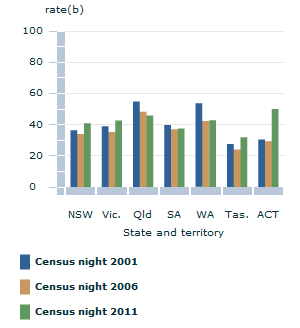
Footnote:
(a) Based on ABS statistical definition of homelessness.
(b) Rates are based on the census count of persons (based on place of usual residence, excluding usual residents of external territories, at sea, migratory and offshore regions).
Source:
ABS Census of Population and Housing: Estimating homelessness, 2011 (cat. no. 2049.0) |
 |  |  |
 |  |  |
 |  |  |
...for the Northern Territory |  |  |
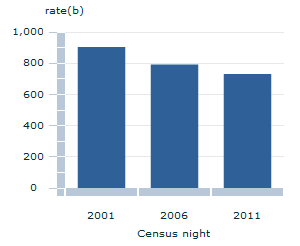
Footnote:
(a) Based on ABS statistical definition of homelessness.
(b) Rates are based on the census count of persons (based on place of usual residence, excluding usual residents of external territories, at sea, migratory and offshore regions).
Source:
ABS Census of Population and Housing: Estimating homelessness, 2011 (cat. no. 2049.0) |  |  |
 |  | |
 |  |  |
 |  |  |
|
| ADEQUATE HOUSING |
 |
Households living in overcrowded conditions(a) |
 |  |  |
 |  |  |
Progress indicator(b) |  | ...for owner households |
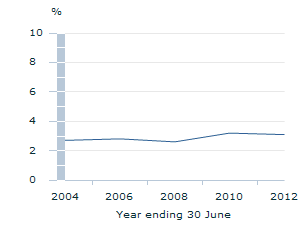
Footnote:
(a) Overcrowded conditions are defined as households requiring one or more extra bedrooms under the Canadian National Occupancy Standard.
(b) Includes other tenure type, which accounted for about 2% of all households in 2011–-12.
Source:
ABS data available on request, Surveys of Income and Housing |  | 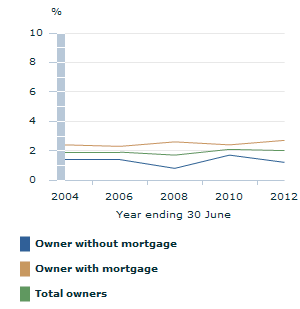
Footnote:
(a) Overcrowded conditions are defined as households requiring one or more extra bedrooms under the Canadian National Occupancy Standard.
Source:
ABS data available on request, Surveys of Income and Housing |
 |  |  |
 |  |  |
 |  |  |
...for renter households |  |  |
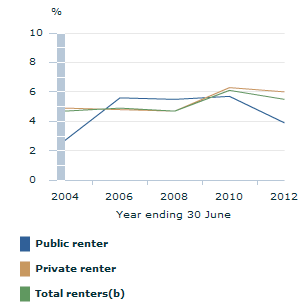
Footnote:
(a) Overcrowded conditions are defined as households requiring one or more extra bedrooms under the Canadian National Occupancy Standard.
(b) Includes other landlord type, which accounted for about 4% of all renters in 2011-12.
Source:
ABS data available on request, Surveys of Income and Housing |  |  |
 |  | |
 |  |  |
 |  |  |
|
| AFFORDABLE HOUSING |
 |
Rental costs(a) as a proportion of household income(b)(c) for low income rental households(d)(e)(f) |
 |  |  |
 |  |  |
Progress indicator |  |  |

Footnote:
(a) Rental costs is amount paid in rent plus general and water rates paid by the household less Commonwealth Rent Assistance (CRA).
(b) Household income is gross household income excluding CRA.
(c) Excludes households with nil or negative household income.
(d) Estimates presented from 2007-08 onwards are not directly comparable with estimates for previous cycles due to improvements made to measuring income introduced in the 2007-08 cycle. Estimates for 2003-04 and 2005-06 have been recompiled to reflect the new treatments of income, however not all new components introduced in 2007-08 are available for earlier cycles.
(e) Low income households are those in the bottom two quintiles of equivalised disposable household income excluding CRA.
(f) Includes other landlord type, which accounted for about 4% of all renters in 2011-12.
Source:
ABS data available on request, Surveys of Income and Housing |  |  |
 |  | |
 |  |  |
 |  |  |
|
| TENURE |
 |  |  |
Households that own their own home |
 |  |  |
 |  |  |
Progress indicator |  |  |
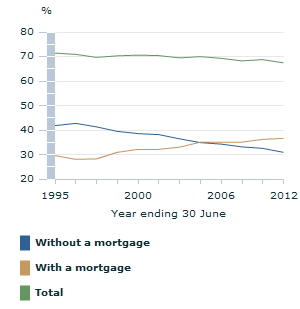
Source:
ABS data available on request, Surveys of Income and Housing |  |  |
 |  | |
 |  |  |
 |  |  |
|
| BELONGING |
 |  |  |
Aboriginal & Torres Strait Islander people who recognise an area as homelands or traditional country(a) |
 |  |  |
 |  |  |
Progress indicator |  | ...by sex |

Footnote:
(a) People aged 15 years and over.
Source:
ABS National Aboriginal and Torres Strait Islander Survey, 1994 (cat no 4190.0)
ABS National Aboriginal and Torres Strait Islander Social Survey, 2002 and 2008 (cat. no. 4714.0) |  | 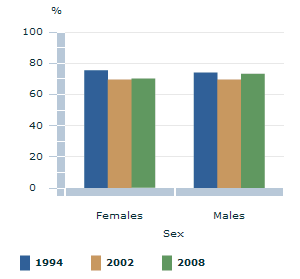
Footnote:
(a) People aged 15 years and over.
Source:
ABS National Aboriginal and Torres Strait Islander Survey, 1994 (cat no 4190.0)
ABS National Aboriginal and Torres Strait Islander Social Survey, 2002 and 2008 (cat. no. 4714.0) |
 |  |  |
 |  |  |
 |  |  |
...by age |  | ...by remoteness |

Footnote:
(a) People aged 15 years and over.
Source:
ABS National Aboriginal and Torres Strait Islander Survey, 1994 (cat no 4190.0)
ABS National Aboriginal and Torres Strait Islander Social Survey, 2002 and 2008 (cat. no. 4714.0) |  | 
Footnote:
(a) People aged 15 years and over.
Source:
ABS National Aboriginal and Torres Strait Islander Survey, 1994 (cat no 4190.0)
ABS National Aboriginal and Torres Strait Islander Social Survey, 2002 and 2008 (cat. no. 4714.0) |
 |  | |
|
|
|
|